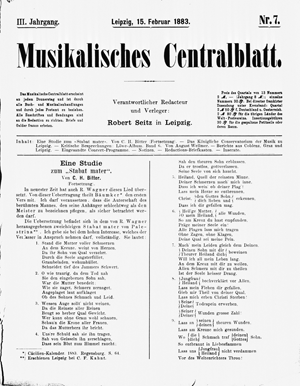Musikalisches Centralblatt
Prepared by Ole Hass
Online only (2012)

The Musikalisches Centralblatt (MCE) appeared weekly in Leipzig from 7 January 1881 to 25 September 1884. The journal was printed by Breitkopf & Härtel and published and edited by Robert Seitz, the proprietor of a small music publishing business, a pianoforte factory and a 300-seat concert hall, as advertised in the journal. The ten- to twelve-page issues are very consistent in structure: an opening article, often printed in installments, followed by "Kritische Besprechungen" [Critical reviews] of recent publications. Correspondence is split into the more detailed "Berichte" [Reports] and the more general "Mittheilungen aus der musikalischen Welt" [News from the musical world], followed by a list of concert programs from around Europe. The "Notizen"[Notes] contains information about musical life, predominantly in Europe, but also in the United States. "Redactions-Briefkasten" [Editor’s mailbox] serves as a place for short messages to contributors and individual readers. The "Inserate" [Advertisements] usually take up the last page of the journal.
In the first lead article, composer Ludwig Meinardus writes about the state musical criticism and responsibility of music critics. Articles on the history of music include contributions by Karl Heinrich Bitter on J. S. Bach and on the many musical settings and translations of the Stabat mater, as well as articles by Hans Michael Schletterer on Pergolesi, by H. Seewald on C. P. E. Bach’s influence on the development of piano playing, and by Arnold Niggli on the creation and first performances of Carl Maria von Weber’s opera Der Freischütz. Wilhelm Freystätter introduces interpretations of Carl Loewe’s ballads by the composer’s daughter, Julie Loewe, and Ludwig Nohl writes about gipsy music. The first issue of 1884 starts a series by G. Wustmann, in which he assembles all entries concerning musical life from a Leipzig chronicle by Johann Salomon Riemer from 1715 to 1777. Some lead articles are reviews of major works, such as that by Carl Maria von Savenau, a frequent contibutor to MCE, of Carl Grammann’s opera Melusine, or the Meinardus’ review in the form of an open letter of Julius Röntgen’s works. A more populist article is that of Ferdinand von Witzleben-Wendelstein on erotic elements in the music of Mozart’s opera Don Giovanni.
The correspondence section features in-depth coverage of Leipzig musical events by the editor, dealing predominantly with the concerts at the Gewandhaus and opera performances at the Leipzig Stadttheater. Regular reports come from other German cities and Copenhagen, London, Vienna and Rome. Special attention is paid to Angelo Neumann, from 1876-82 director of the Leipzig Stadttheater, who, after staging Richard Wagner’s Der Ring des Nibelungen at the Victoria-Theater in Berlin in 1881, formed the Richard Wagner Theatre, with which he toured Germany in 1882. Reports of Johannes Brahms’ tours, conducting and playing his own compositions, such as the Academic Festival Overture and the Tragic Overture, his Piano Concerto no. 2 and his Symphony no. 3, come from cities such as Leipzig, Berlin, Dresden, Frankfurt am Main, Hamburg and Cologne, and give insight to the early reception of these compositions. Performances of works by Anton Rubinstein and his appearances as pianist and conductor are prominent, as are the activities of musical personalities such as the violinist Joseph Joachim and his wife, mezzo-soprano Amalie Joachim, violinist Theresina Tua, pianist Eugen d’Albert and many others. Reviews and correspondence also give much consideration to new operas, especially the many new productions of the Hamburg State Opera under Pollini, including those of Heinrich Marschner’s König Hiarne, Alexander Mackenzie’s Colomba and William Faber’s Spanische Studenten. During the summer months, reports from the many music festivals in Germany dominate the correspondence. An article by L. Rost on a scene from Meinardus’ oratorio Luther in Worms was left incomplete by the sudden demise of the journal owing to Robert Seitz’ bankruptcy.
